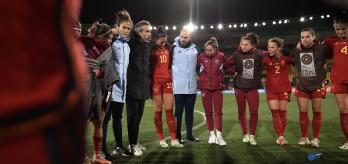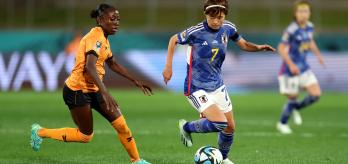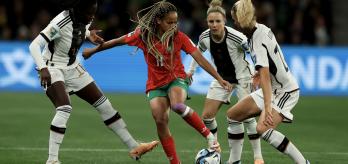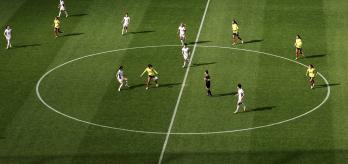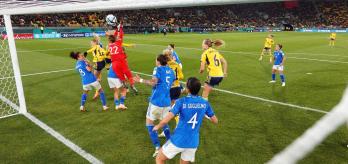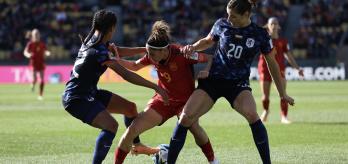Four of Sweden's seven goals in the competition to date have been scored in the first phase following a corner kick: one featured in their opening game against South Africa and three defined the Blågult's 5-0 victory over Italy. Peter Gerhardsson's players acknowledge this is a key strength in their attacking armoury and that they put a lot of work into creating their set play routines. Speaking to the media after their latest win, corner-taker Jonna Andersson explained how the team analyses which types of corners to use in different games.
"We decide how to do it game-by-game, depending on where the strongest and weakest players are. (In this match) we focused on the near post, and it worked really well. It's very difficult for teams to defend against those kinds of crosses," she explained.
Key insights
-
To decide on an attacking corner strategy, a team must first consider two key factors: their own strengths during set plays and the opponent's defending corner structure.
-
Attacking runs and decoy runs should start from pre-determined positions and be timed in relation to the expected delivery of the ball.
-
The team that wins the first and second contact of the ball after a corner kick will have a significant advantage in determining the outcome of the set piece.
Line-ups
SWEDEN'S EFFECTIVE ATTACKING CORNERS
In their game against Italy, Sweden had seven attacking corners. All of these were delivered as in-swingers to the front of the goal area and placed in between the near post and the goalkeeper. Gerhardsson's side scored from two of the three corners where they claimed the first contact, and converted a third corner from a second contact.
Having also scored with the first contact from a corner against South Africa, Sweden have now registered four goals in the first phase following a corner kick in their opening two games. In total, Sweden were first to the ball eight times (40%) from their total of 20 corners in these two games, placing them ahead of the tournament benchmark of 33% at this stage of the competition.
Of these 20 corners, Sweden have delivered 19 directly into the penalty area and played a short corner once.
Set-Up
Sweden had two designated corner-takers in their game against Italy. Left-footed Jonna Andersson (2) delivered in-swingers from the right side and right-footed Kosovare Asllani (9) provided the same type of deliveries from the left.
On the receiving end, the Blågult consistently stationed five players in the goal area, one of which would have the role of occupying the opposition's goalkeeper. Two other team-mates would start on the edge of the penalty area and pick up second balls or secure possession from attempted clearances. An additional player positioned themselves further out to cover the back of the box. If the Sweden players on the edge of the area were not picked up by opposition defenders, they could become potential targets for deliveries or second contacts in the space between the penalty spot and the edge of the penalty area.
Because Italy brought all ten outfield players back to defend corner kicks, Sweden kept just one player closer to their own half for defensive cover should Italy launch a counter-attack.
As a variation, Sweden sometimes brought a second player out alongside their corner-taker. This would entice two Italy defenders out of their penalty area to prevent the short corner.
Crowding the area around the goalkeeper
By having five players in the goal area, Sweden actively crowded the space that the goalkeeper needs to dominate. With Italy's own defending players also in this area, the space became even more dense, creating less room for the goalkeeper to be able to claim high balls.
In the clip below we see Sweden's attacking corner set-up and the roles of their players. The primary space they want to attack (the area between the near post and the goalkeeper) is occupied by intended target Amanda Ilestadt (13), Stina Blackstenius (11) and Nathalie Björn (14).
The secondary space is also well covered by the attacking team. Fridolina Rolfö (18) occupies the back of the goal area in case of a flick-on, Magdalena Eriksson (6) takes up a position in line with the back post and Asllani covers the back space further out in the penalty area.
As Signeul explains, "They crowd the goal area and place players within the frame of the goal to compete for second balls or attack any inaccurate deliveries. By creating so much 'traffic' in this area, it is very difficult for the goalkeeper to take a positive first step and achieve the elevation required to claim the high ball."
Timing and Quality of Delivery
An accurate delivery into this area coupled with a well-timed action to make first contact with the ball is very difficult to defend against. Executing an attacking set piece of this calibre requires players to understand their starting positions and the desired points of attack. The delivery itself then has to have the necessary speed, trajectory and accuracy. Left-back Andersson's corner kicks met this criteria and were crucial to her team's success from the corner flag. The quality of her deliveries can be seen in the clips at the end of this section.
According to Signeul, "You can see she works on her technique a lot. The consistent accuracy in her deliveries is just so impressive and she beats the first defender every time. The timing of Ilestadt's first step and jump are also perfect. You need both components for the goal to be scored. You can see she has a height advantage in the aerial duels, but the key detail is in the accuracy of the delivery and the timing of the attempt on goal."
In the clips below we see the two first-contact goals Ilestadt scored from Sweden's attacking corner routine versus Italy. The accuracy of the deliveries and the timing of Ilestadt's attacking actions make them a carbon copy of each other.
Second contact
Sweden's attacking corner structure was not only designed for first-contact goals. As Signeul alluded to earlier, they positioned players to 'frame' the goal, meaning they could be ready to react quickly to opportunities from second balls.
In the clip below, Sweden score another goal against Italy from the same routine and set-up seen in the previous clips. However, on this occasion Andersson's cross gets flicked on from the near post by Italy's Barbara Bonansea (8), but Rolfö is perfectly positioned at the back post to strike from the second contact.
The key to maximising goal-scoring opportunities from second balls or second contacts is having players located in the key zones of the goal area and around the penalty box. Here they should cover as much space as possible and be ready to react quickly to any ball coming their way.


